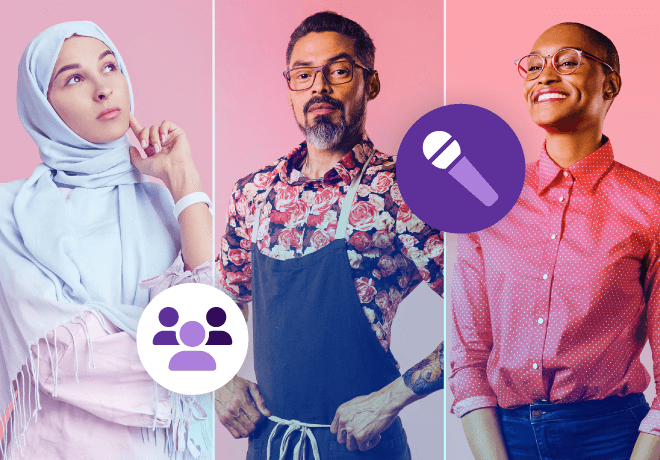
Learner personas: what they are and why you need them
When creating online training, instructional designers need to focus on the goals of the training and the content, of course, but it’s equally important to focus on the learners. Effective training has to work for the learners who will use it, and creating learner personas is one way to make that happen.
If the training content is over learners’ heads — or far too basic — it will fail. If the training demands technical skills that learners lack or it’s in a format they can’t or won’t use, the learners won’t engage with it, won’t learn the content, and won’t change their behavior or improve their performance.
Learner personas can help.
Use your learner personas to imagine a typical learner
A learner persona is a prototype — of a learner! Since your learner pool is likely diverse in terms of learners’ demographics, level of knowledge of the topic, length of time at the company, and technical skill and preferences, you might need several personas. Some experts recommend using three to five personas to capture a variety of characteristics common among your learners and ensure that your online training is inclusive and accessible.
The persona is, essentially, a fake learner. The persona has a name, an age, perhaps a family; they have likes and dislikes, a life story and, critically, a work history.
One persona, Amanda, might be a 30-something woman who loves watching videos and communicates almost exclusively by text message. She is constantly attached to her smartphone and is tech-savvy from a consumer perspective but has little knowledge of how technology actually works. She’s been a customer support specialist with your company for 6 years and is the person her colleagues seek out when they have questions or problems.
A second persona, Maurice, could be a late-40s male who prefers to read text-based content, has extensive coding experience, but is brand-new to your organization. He dislikes audio and video content since he has a mild hearing impairment and he’s embarrassed when he has to ask for content to be repeated. Maurice has quickly bonded with members of the IT team, and they get together after work to play video games. But he’s struggling to master some of the day-to-day tasks in your customer service department, where he works.
The abstract ‘learner’ becomes relatable
A learner persona takes an abstract “learner” and gives them a name, a face, and a personality. Designers and developers can then talk about what Amanda or Maurice would engage with, which skills they need most to learn, and how they are likely to interact with and respond to your training materials.
Understanding these personas — who are stand-ins for your actual learners with similar preferences and traits — can influence how you present training content, starting with your choice of training platform and delivery medium.
Your personas should reflect your learners

To create useful personas, start by interviewing actual learners — your learners. Interview a variety of employees who are in roles where they might be asked to use the training you are developing. If you are creating onboarding training, talk with newer hires in as many departments as you can. If the training is targeted to a specific department or job role, focus your interviews there.
Find out what your learners love and hate about training they’ve done, both at your organization and elsewhere. Ask about their goals, what their managers want them to learn, and what they struggle with. Ask them how they search for information when they have a question or work-related problem to solve — and how they problem-solve when they’re not at work. Ask follow-up questions about why they like or dislike specific approaches or media. And pay attention to what they seem to be excited about (or angry or frustrated about).
Your personas won’t reflect any of these individual learners; they will be composites based on all of the information you gather in your interviews.
Personas increase training relevance
When developers imagine how a relatable, if fictional, person will use their online training products, they are more likely to create relevant and inclusive training.
The developers can visualize how Amanda might struggle to navigate training in an unfamiliar format — or they could decide to use a mobile-first approach to the training design based on Amanda’s penchant for doing everything on her phone. With an eye toward Maurice, the development team might move some of the deeper technical content to linked eBooks and articles and choose to teach some basic customer support skills using gamification or microlearning. They might also include a searchable library that recaps those skills and processes, which both personas are likely to use extensively.
Considering learners’ preferences, skills, and life stories can guide eLearning designers toward choices that work for their learners. While Amanda might skip some of the games that teach basic content, a microlearning quick-reference library could be useful to her, especially when her colleagues come to her with questions about tasks she rarely does. And when Maurice is struggling to remember how to do something, an efficient performance support library is a valuable job aid.
Improve engagement and training outcomes with personas
By creating personas that reflect broadly shared characteristics of members of the actual learner population, instructional designers and eLearning developers identify realistic use cases and can accurately envision the way real people will interact with the online training. By targeting the training to the personas, the end result is likely to be more relevant and engaging training, resulting in improved outcomes.
Learning Hub: free resources for eLearning
The Neovation Learning Hub contains many free resources and articles that can help you improve eLearning outcomes at your organization. Continue learning about Custom eLearning Development topics, find out why your organization should care about accessibility, read articles on Instructional Design, or find new eLearning tools to help you with your eLearning initiatives.





-svg.svg)
-svg.svg)
-svg.svg)
-svg.svg)